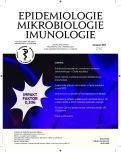A Novel Typing Method and Scheme for Streptococcus pneumoniae
Authors:
Vacková Zuzana; Klímová Martina; Kozáková Jana
Published in:
Epidemiol. Mikrobiol. Imunol. 62, 2013, č. 2, s. 50-58
Overview
Study aim:
To introduce a novel molecular PCR method for the typing of Streptococcus pneumonia in the National Reference Laboratory (NRL) for Streptococcal Infections.
Material and Methods:
Strains of Streptococcus pneumoniae are referred to the NRL from different regions of the Czech Republic. Generally, the identification and typing are based on strain morphology, optochin susceptibility, bile solubility, latex agglutination, and the Quellung reaction. Since 2012, a novel multiplex polymerase chain reaction (mPCR) assay has been introduced. The novel assay was tested on 210 S. pneumoniae isolates and 8 isolates of the related species S. pseudopneumoniae, S. sanguinis, and S. oralis.
Results:
The NRL for Streptococcal Infections has included a novel mPCR assay in the algorithm of S. pneumoniae identification and typing. The mPCR assay was able to identify and type any pneumococcal strain from the study collection, with the isolates of the related species remaining negative. The mPCR assay showed 100% sensitivity and specificity in this study. The pCR appeared to be an excellent tool for S. pneumoniae typing.
Conclusion:
Until recently, S. pneumoniae serotypes and serogroups were differentiated using a serological approach (Quellung reaction), but the NRL for Streptococcal Infections has switched to a novel mPCR assay. This molecular tool improves S. pneumoniae typing, making it more accurate.
Keywords:
PCR typing of Streptococcus pneumoniae – Quellung reaction – Streptococcus pneumoniae
Sources
1. Motlová, J., Beneš, Č., Kozáková, J., Křížová, P. Invazivní pneumokoková onemocnění v České republice v roce 2011. Zprávy CEM, 2012, 21, p. 51–58.
2. Bratcher, P. E., Park, I. H., Hollingshead, S. K. & Nahm, M. H. Production of a unique pneumococcal capsule serotype belonging to serogroup 6. Microbiology, 2009, 155, p. 576–583.
3. Zemlickova, H., Jakubu, V., Urbaskova, P., Motlova, J., Musilek, M., Adamkova, V. Serotype-specific invasive disease potential of Streptococcus pneumoniae in Czech children. J. Med. Microbiol., 2010, 59, p. 1079–1083.
4. Motlova, J., Benes, C., Kriz, P. Incidence of invasive pneumococcal disease in the Czech Republic and serotype coverage by vaccines, 1997–2006. Epidemiol. Infect., 2009, 137, p. 562–569.
5. Prymula, R., Motlova, J., Kriz, P. Comparison of Streptococcus pneumoniae serotypes causing acute otitis media & invasive disease in young children in the Czech Republic. Indian. J. Med. Res., 2004, 119, p. 168–170.
6. Merrill, C. W, Gwaltney, J. M. Jr., Hendley, J. W., Sande, M. A. Rapid identification of pneumococci. Gram stain vs. the quellung reaction. N. Engl. J. Med., 1973, 288, p. 510–512.
Dostupné na www:
http://www.ssi.dk/English/SSI%20Diagnostica/Products%20from%20SSI%20Diagnostica/Antisera_antibodies/Pneumococcus%20antisera/Neufeld.aspx.
7. Siira, L., Kaijalainen, T., Lambertsen, L., Nahm, M. H., Toropainen, M., Virolainen, A. From Quellung to Multiplex PCR, and back when needed, in pneumococcal serotyping. J. Clin. Microbiol., 2012, 50, p. 2727–2431.
8. The Centers for Disease Control and Prevention Specifické primery dle CDC, Atlanta, USA. Dostupné na www: http://www.cdc.gov/ncidod/biotech/strep/pcr.htm.
9. Manuál QIAamp DNA Mini Kit. Dostupné na www:
http://www.qiagen.com/Products/Catalog/Sample-Technologies/DNA-Sample-Technologies/Genomic-DNA/QIAamp-DNA-Mini-Kit#technicalspecification.
10. Bratcher, P. E., Kim, K. H., Kang, J. H., Hong, J. Y., Nahm, M. H. Identification of natural pneumococcal isolates expressing serotype 6D by genetic, biochemical and serological characterization. Microbiology, 2010, 156, p. 555–560.
11. Oftadeh, S., Satzke, C., Gilbert, G. L. Identification of newly described Streptococcus pneumoniae serotype 6D by use of the Quellung reaction and PCR. J. Clin. Microbiol., 2010, 48, p. 3378–3379.
Labels
Hygiene and epidemiology Medical virology Clinical microbiologyArticle was published in
Epidemiology, Microbiology, Immunology

2013 Issue 2
Most read in this issue
- Intravenous and Subcutaneous Immunoglobulin Therapy
- Antibiotická rezistence u netyfových sérovarů Salmonella spp. v České republice
- A Novel Typing Method and Scheme for Streptococcus pneumoniae
- Prevalence Estimates of Problem Drug Users in the Czech Republic in 2006 and 2007 using the Capture-Recapture Method
